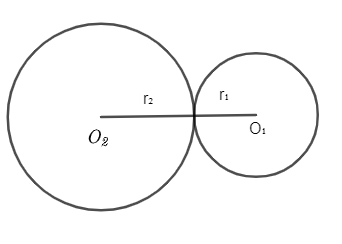
Answer
497.4k+ views
Hint: Consider 2 triangles with centre ${{r}_{1}}$and${{r}_{2}}$. We have been given combined area and distance between centres of radius. Substitute there in the sum of areas. Simplify it to a quadratic equation and roots will give the radius of both circles.
Complete step-by-step answer:
Let us consider two circles with centres ${{O}_{1}}$ and ${{O}_{2}}$. Let ${{r}_{1}}$be the radius of circle 1 and ${{r}_{2}}$ be the radius of circle 2.

Given that the distance between the centers of circle 1 and 2 is 14cm.
$\begin{align}
& \Rightarrow {{r}_{1}}+{{r}_{2}}=14 \\
& \therefore {{r}_{2}}=14-{{r}_{1}}\ldots \ldots (1) \\
\end{align}$
Given that the sum of areas of 2 circles is $130\pi $
Let ${{A}_{1}}$ be the area of circle 1 and ${{A}_{2}}$be the area of circle 2.
$\therefore {{A}_{1}}+{{A}_{2}}=130\pi \ldots \ldots (2)$
We know area, \[A=\pi {{r}^{2}}\]
$\therefore {{A}_{1}}=\pi {{r}_{1}}^{2},{{A}_{2}}=\pi {{r}_{2}}^{2}$; cancel $\pi $ from RHS & LHS
$\therefore \pi {{r}_{1}}^{2}+\pi {{r}_{2}}^{2}=130\ldots \ldots (3)$
Substitute equation (1) in equation (3)
${{r}_{1}}^{2}+{{\left( 14-{{r}_{1}} \right)}^{2}}=130$
We know that,
$\begin{align}
& {{\left( a-b \right)}^{2}}={{a}^{2}}-2ab+{{b}^{2}} \\
& \Rightarrow {{r}_{1}}^{2}+{{14}^{2}}-2\times 14{{r}_{1}}+{{r}_{1}}^{2}=130 \\
& \Rightarrow {{r}_{1}}^{2}-28{{r}_{1}}+{{r}_{1}}^{2}=130-96 \\
& \therefore 2{{r}_{1}}^{2}-28{{r}_{1}}=-66 \\
& \Rightarrow 2{{r}_{1}}^{2}-28{{r}_{1}}+66=0\ldots \ldots (4) \\
\end{align}$
Divide throughout by 2 in equation (4)
$\Rightarrow {{r}_{1}}^{2}-14{{r}_{1}}+33=0\ldots \ldots (5)$
The obtained equation (5) is similar to the general equation $a{{x}^{2}}+bx+c=0$. So comparing them we get a=1, b=-14, c=33.
Substitute the values in quadratic equation,
$\begin{align}
& \dfrac{-b\pm \sqrt{{{b}^{2}}-4ac}}{2a}=\dfrac{-(-14)\pm \sqrt{{{\left( -14 \right)}^{2}}-4\times 1\times 33}}{2\times 1} \\
& =\dfrac{14\pm \sqrt{196-32}}{2}=\dfrac{14\pm \sqrt{64}}{2}=\dfrac{14\pm 8}{2} \\
\end{align}$
$\therefore $Roots are $\left( \dfrac{14+8}{2} \right)$and $\left( \dfrac{14-8}{2} \right)$= 11 and 3 cm.
$\therefore $${{r}_{1}}$=11cm
${{r}_{2}}$=14-${{r}_{1}}$=3cm
Radii of two circles are 11cm and 3cm.
Note: When ${{r}_{1}}$=11cm, substituting ${{r}_{2}}$=14-11=3cm. Similarly if ${{r}_{1}}$=3cm, substituting ${{r}_{2}}$=14-3=11cm
So the radius of two circles is 11cm and 3cm, irrespective of where the bigger and smaller circle comes.
Complete step-by-step answer:
Let us consider two circles with centres ${{O}_{1}}$ and ${{O}_{2}}$. Let ${{r}_{1}}$be the radius of circle 1 and ${{r}_{2}}$ be the radius of circle 2.

Given that the distance between the centers of circle 1 and 2 is 14cm.
$\begin{align}
& \Rightarrow {{r}_{1}}+{{r}_{2}}=14 \\
& \therefore {{r}_{2}}=14-{{r}_{1}}\ldots \ldots (1) \\
\end{align}$
Given that the sum of areas of 2 circles is $130\pi $
Let ${{A}_{1}}$ be the area of circle 1 and ${{A}_{2}}$be the area of circle 2.
$\therefore {{A}_{1}}+{{A}_{2}}=130\pi \ldots \ldots (2)$
We know area, \[A=\pi {{r}^{2}}\]
$\therefore {{A}_{1}}=\pi {{r}_{1}}^{2},{{A}_{2}}=\pi {{r}_{2}}^{2}$; cancel $\pi $ from RHS & LHS
$\therefore \pi {{r}_{1}}^{2}+\pi {{r}_{2}}^{2}=130\ldots \ldots (3)$
Substitute equation (1) in equation (3)
${{r}_{1}}^{2}+{{\left( 14-{{r}_{1}} \right)}^{2}}=130$
We know that,
$\begin{align}
& {{\left( a-b \right)}^{2}}={{a}^{2}}-2ab+{{b}^{2}} \\
& \Rightarrow {{r}_{1}}^{2}+{{14}^{2}}-2\times 14{{r}_{1}}+{{r}_{1}}^{2}=130 \\
& \Rightarrow {{r}_{1}}^{2}-28{{r}_{1}}+{{r}_{1}}^{2}=130-96 \\
& \therefore 2{{r}_{1}}^{2}-28{{r}_{1}}=-66 \\
& \Rightarrow 2{{r}_{1}}^{2}-28{{r}_{1}}+66=0\ldots \ldots (4) \\
\end{align}$
Divide throughout by 2 in equation (4)
$\Rightarrow {{r}_{1}}^{2}-14{{r}_{1}}+33=0\ldots \ldots (5)$
The obtained equation (5) is similar to the general equation $a{{x}^{2}}+bx+c=0$. So comparing them we get a=1, b=-14, c=33.
Substitute the values in quadratic equation,
$\begin{align}
& \dfrac{-b\pm \sqrt{{{b}^{2}}-4ac}}{2a}=\dfrac{-(-14)\pm \sqrt{{{\left( -14 \right)}^{2}}-4\times 1\times 33}}{2\times 1} \\
& =\dfrac{14\pm \sqrt{196-32}}{2}=\dfrac{14\pm \sqrt{64}}{2}=\dfrac{14\pm 8}{2} \\
\end{align}$
$\therefore $Roots are $\left( \dfrac{14+8}{2} \right)$and $\left( \dfrac{14-8}{2} \right)$= 11 and 3 cm.
$\therefore $${{r}_{1}}$=11cm
${{r}_{2}}$=14-${{r}_{1}}$=3cm
Radii of two circles are 11cm and 3cm.
Note: When ${{r}_{1}}$=11cm, substituting ${{r}_{2}}$=14-11=3cm. Similarly if ${{r}_{1}}$=3cm, substituting ${{r}_{2}}$=14-3=11cm
So the radius of two circles is 11cm and 3cm, irrespective of where the bigger and smaller circle comes.
Recently Updated Pages
10 Examples of Evaporation in Daily Life with Explanations

10 Examples of Diffusion in Everyday Life

1 g of dry green algae absorb 47 times 10 3 moles of class 11 chemistry CBSE

If x be real then the maximum value of 5 + 4x 4x2 will class 10 maths JEE_Main

If the coordinates of the points A B and C be 443 23 class 10 maths JEE_Main

What happens when dilute hydrochloric acid is added class 10 chemistry JEE_Main

Trending doubts
Fill the blanks with the suitable prepositions 1 The class 9 english CBSE

Which are the Top 10 Largest Countries of the World?

How do you graph the function fx 4x class 9 maths CBSE

Differentiate between homogeneous and heterogeneous class 12 chemistry CBSE

Difference between Prokaryotic cell and Eukaryotic class 11 biology CBSE

Change the following sentences into negative and interrogative class 10 english CBSE

The Equation xxx + 2 is Satisfied when x is Equal to Class 10 Maths

In the tincture of iodine which is solute and solv class 11 chemistry CBSE

Why is there a time difference of about 5 hours between class 10 social science CBSE




